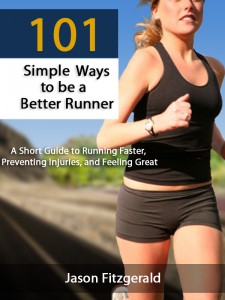Does consistent training sound…kind of boring?

It doesn’t have to be! To stay interested and continue progressing with your running, you have to upgrade your training and introduce more variety.
To quote Jay Johnson:
To do something you’ve never done before, you have to do something you’ve never done before.
In other words: boredom is the running shoe into which poor training slips its foot.
Did I just butcher that quote? Oh well, click here to tweet it out!
A side benefit of running a varied training program is that you’re going to prevent more injuries. An overuse injury happens from too much repetition and training variety can help you stay healthy.
Anyway, below are seven ways to introduce more variety into your running. They’re excerpts from my book 101 Simple Ways to be a Better Runner: A Short Guide to Running Faster, Preventing Injury, and Feeling Great – a Top 50 Sports book on Amazon.
No Kindle? No worries! Download the book now as a PDF.
Don’t forget to read to the end – I’m giving away three PR Race Plans!
Don’t be a one trick pony when you’re getting strong
Make sure your core and strength workouts challenge your body in all three planes of motion: front and back, lateral, and rotational. Since running is all front and back motion, it’s important to move in different planes of motion to stay athletic and improve your injury resistance.
Here are a few exercises that help you do this:
- Lunge forward and rotate your trunk to the side and back as you lunge
- Side plank
- Side leg lifts
- Side lunges
- Hay bales with a medicine ball (squat down with a med ball, then as you raise up you lift the ball up and to your side. Rotate your trunk and watch the ball as you rotate it to your side.)
Running creates imbalances because it’s a repetitive movement in one plane of motion. Counteract those imbalances with exercises in multiple planes of movement to stay healthy.
Run different types of long runs
Long runs don’t have to be the same pace. In fact, you can squeeze even more fitness out of your long runs by varying the terrain and pace that you run in the later miles.
Three of my favorite types of long run variations include:
- Hilly long runs: run several long hills in the final 2-5 miles or run one long hill of 5-10 minutes in the final 1-2 miles of your run.
- Long runs with surges: With 1-2 miles left in your long run, start a short fartlek workout. My favorites include 8 x 30 seconds at your 10k pace with a 1-2 minute jogging recovery or 6 x 1 minute at your tempo pace with a 1-2 minute jogging recovery.
- Progressions: In the final 2-5 miles of your long run, gradually pick up the pace so you end your run at your tempo or 10k pace. This is definitely an advanced type of workout, but it’ll help you gain even more endurance as you teach your body to run fast when it’s tired.
These are slightly more advanced versions of the standard long run, so progress intelligently and start with hills, then do a fartlek long run, and finally end with the progression.
Race a distance you’ve never run before
What’s so special about running a new distance? First, you’ll get an automatic PR! Setting a benchmark in a new distance gives you an entirely new race distance to think about and plan for.
But more importantly, training for a new race distance means your training is going to be slightly different. If it’s a longer race, you’ll likely need more challenging long runs and longer workouts. For shorter races, you’ll need the opposite: faster workouts and an emphasis on developing your speed.
Aside from the physical benefits of racing a new distance, this is another example of a “small win” – it will give you a PR and a whole new race experience.
Heart-rate monitors don’t make you faster
Too many runners think they need the fanciest gear to help them get faster. Heart rate monitors aren’t necessary to be a good runner, but they can be a useful training tool for a more advanced runner.
There are two specific types of workouts that lend themselves very well to heart rate training: recovery runs and tempo runs. It’s important to make recovery runs truly easy so a heart rate monitor can keep you honest and make sure you’re not working too hard.
Tempo workouts are typically run at about 85-90% of your maximum heart rate. You can use a heart rate monitor to determine your max heart rate and then work at the correct percentage. It may not be completely accurate, but it can be a valuable tool to help inform your workouts.
Take this challenge: eat vegetables at every meal for a week
We all know that we need to eat more veggies. But aside from the serving of vegetables we have for dinner, most of us don’t eat as much as we should. For one week, challenge yourself to eat a serving (or more!) of veggies at every meal.
Here’s a sample menu to get you started:
Breakfast: scrambled eggs with chopped mixed vegetables, topped with salsa and avocado. Optional: Put it on a bagel or piece of bread for a great home-made breakfast sandwich.
Lunch: Salad with olive oil based dressing, chicken, and a V8.
Snack: Carrots dipped in almond or peanut butter.
Dinner: Steamed broccoli, fish, sauteed eggplant, wild rice.
Snack: Ice cream (go wild!)
Embrace your coffee addiction
Coffee (caffeine) improves running performance – plain and simple. It fundamentally changes how muscles function, making them contract more quickly and forcefully. It also changes how you perceive running-related fatigue and “pain,” allowing you to run faster before you start slowing down.
Aim to consume about 1.5mg of caffeine per pound of bodyweight about an hour before you race or run a hard workout. This is about 10-14 ounces of standard brewed coffee. Just make sure you’re accustomed to coffee’s effects on your GI system before you try it before a race (coffee makes you go to the bathroom, in case you’re not aware of this).
The only thing that can be unhealthy about coffee is what you put in it. Be wary of artificial sweeteners, use only as much sugar as you need, and opt for whole milk as opposed to flavored creamers which usually have a lot of chemicals in them.
Beware of the office – move around!
If you have an office job, stay loose throughout the day. Sitting in the same position for 8+ hours is not only bad for your general health, but you’ll be creating muscle imbalances and decreasing your range of motion.
Here are a few ideas that can help you stay loose throughout your day:
- take frequent walk breaks
- use a standing work station
- sit on an ergonomic chair (or Swiss ball)
- don’t call your colleague; walk to her desk
- take the stairs
- print to the far side of the office
- have standing meetings
The options are endless; just make sure you alternate your positions throughout the day and keep moving around.
There’s still time to win a free personalized training plan!
I’m giving away THREE custom training plans. Here’s what to do:
- Buy the book on Amazon or as an instant download.
- Read it and then immediately run faster than ever.
- Leave a review on Amazon (honest reviews only).
- Email me (support@strengthrunning.com) to tell me you reviewed the book and want to be in the giveaway.
You have until 6/10/2012 to email me about your review and then I’ll randomly choose three winners. As of this writing, you have a 33% chance of winning!
That’s it. It’s easy.
Questions? Let me know in the comments below and I’ll clarify for you.
[Note: This giveaway is now over]